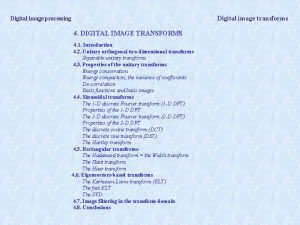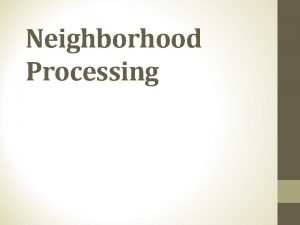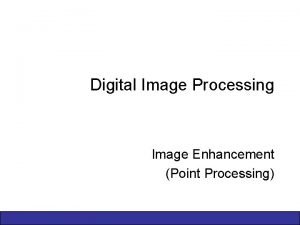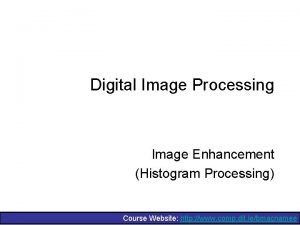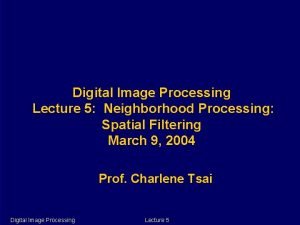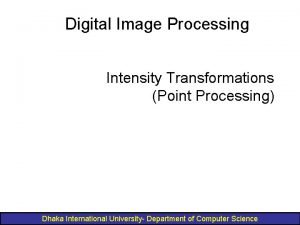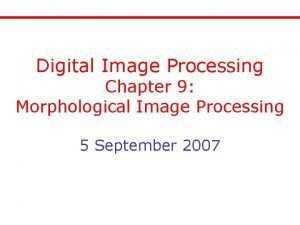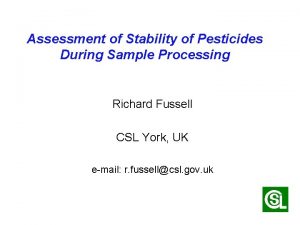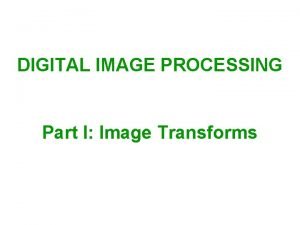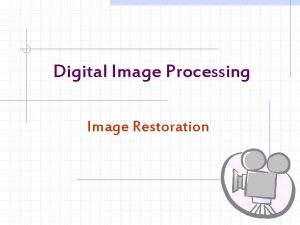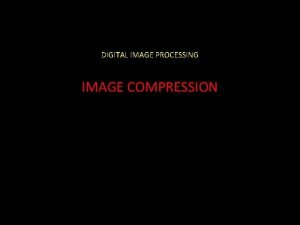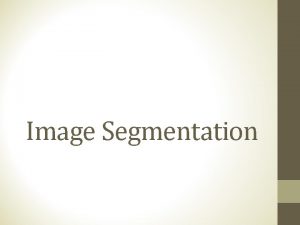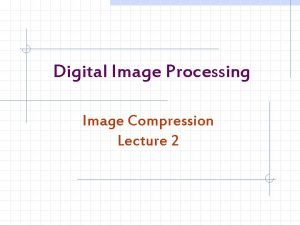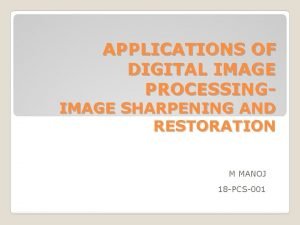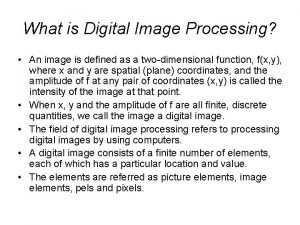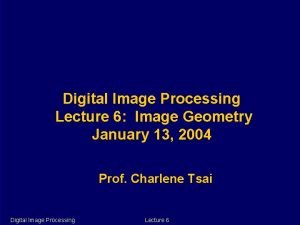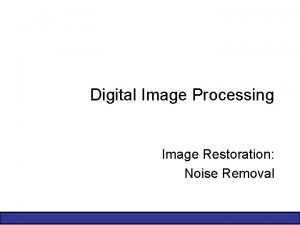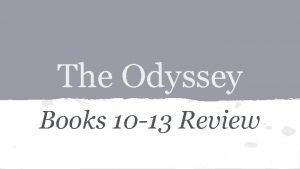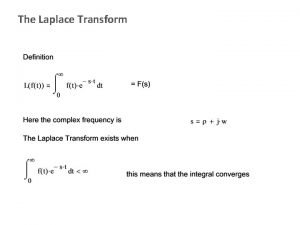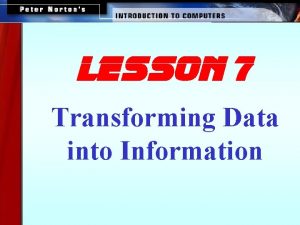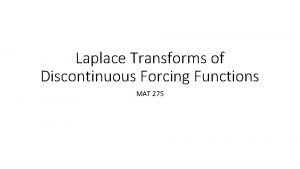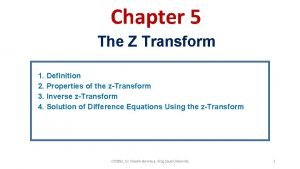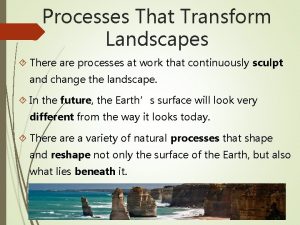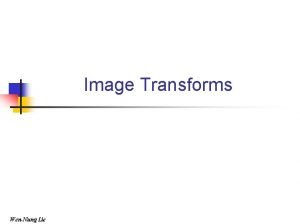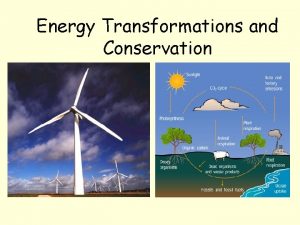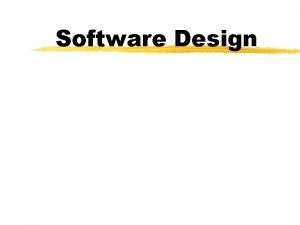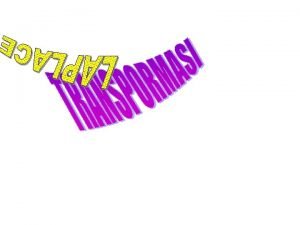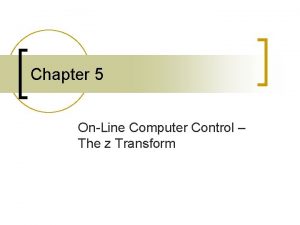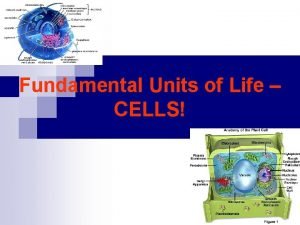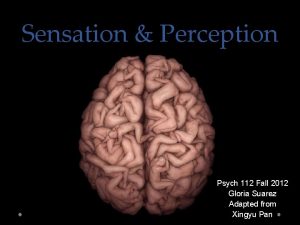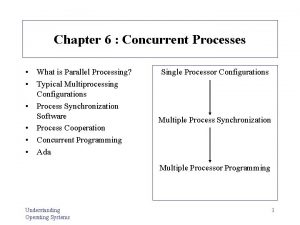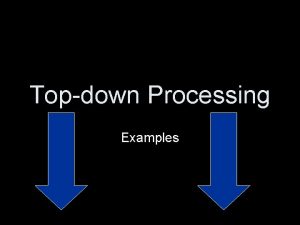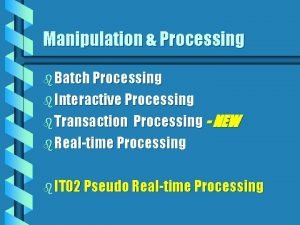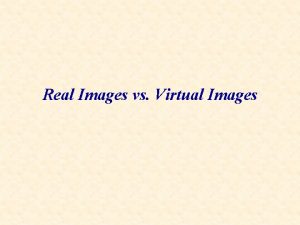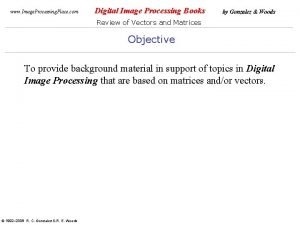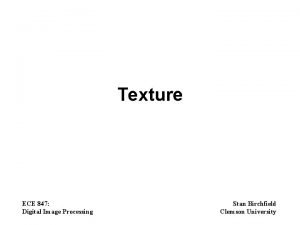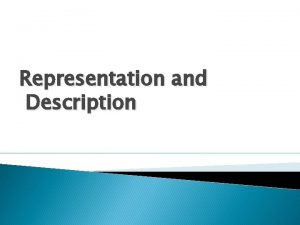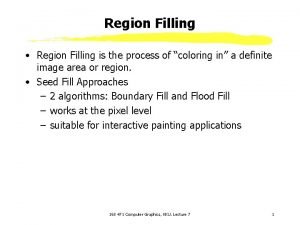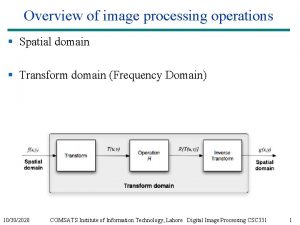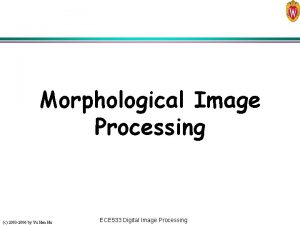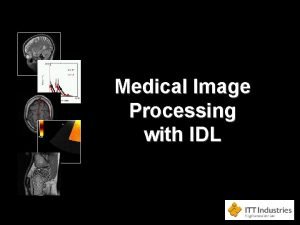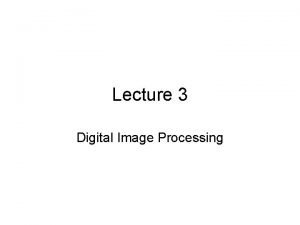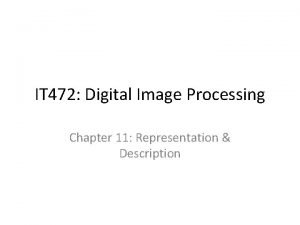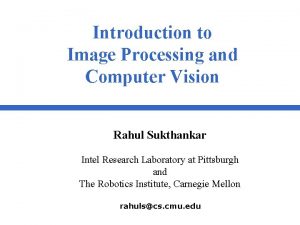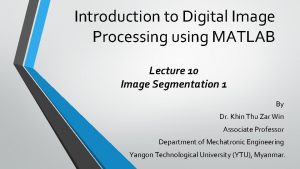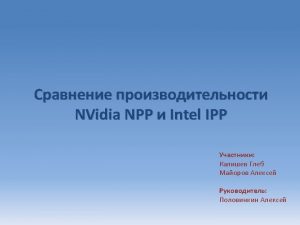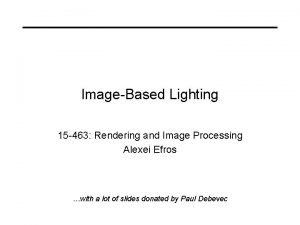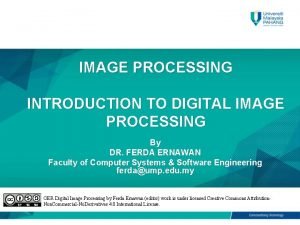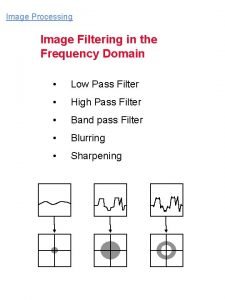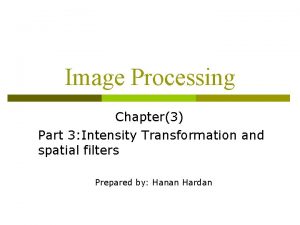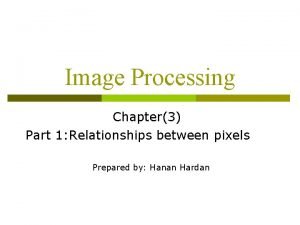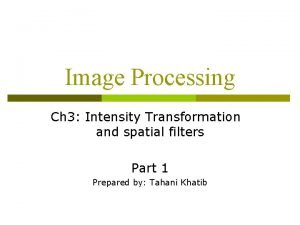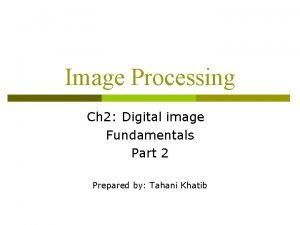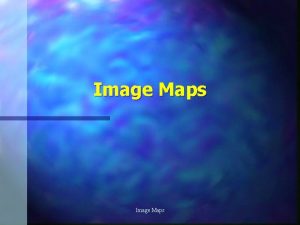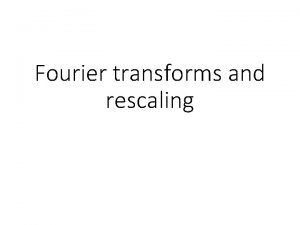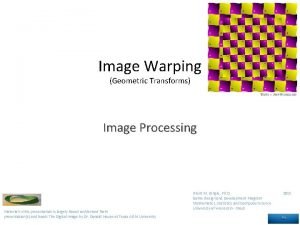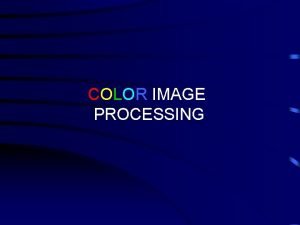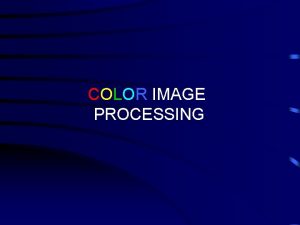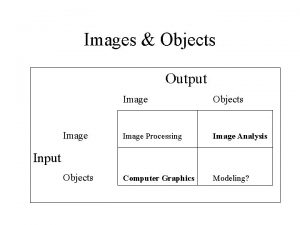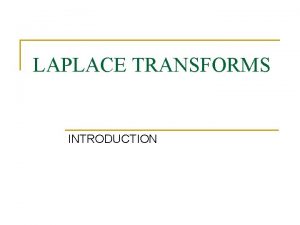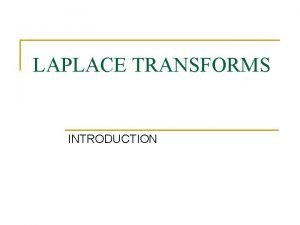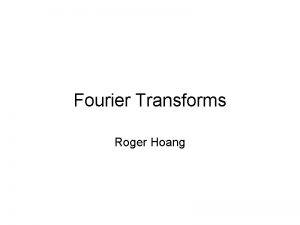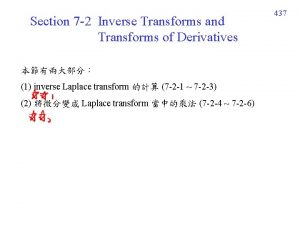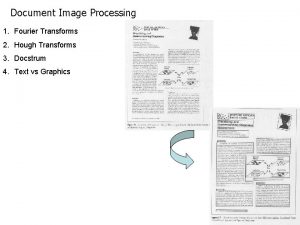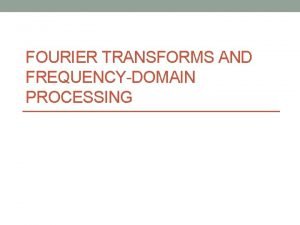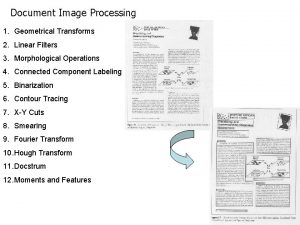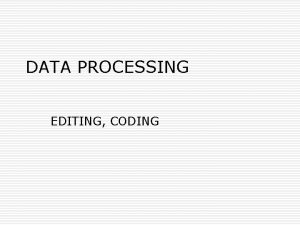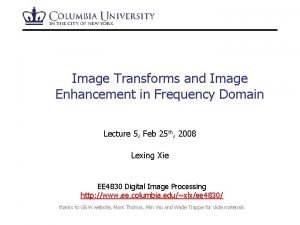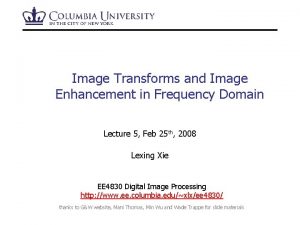Image Transforms Transforming images to images Image Processing


































































- Slides: 66

Image Transforms Transforming images to images Image Processing and Computer Vision: 2

Classification of Image Transforms n Point transforms n n n Local transforms n n modify individual pixels modify pixels’ locations output derived from neighbourhood Global transforms n whole image contributes to each output value Image Processing and Computer Vision: 2 2

Point Transforms n Manipulating individual pixel values n n n Histogram manipulation n n Brightness adjustment Contrast adjustment equalisation Image magnification Image Processing and Computer Vision: 2 3

Grey Scale Manipulation n Brightness modifications Contrast modifications Histogram manipulation Image Processing and Computer Vision: 2 4

Brightness Adjustment Add a constant to all values g’ = g + k (k = 50) Image Processing and Computer Vision: 2 5

Contrast Adjustment Scale all values by a constant g’ = g*k (k = 1. 5) Image Processing and Computer Vision: 2 6

Image Histogram n Measure frequency of occurrence of each grey/colour value Image Processing and Computer Vision: 2 7

Histogram Manipulation n Modify distribution of grey values to achieve some effect Image Processing and Computer Vision: 2 8

Equalisation/Adaptive Equalisation n Specifically to make histogram uniform Image Processing and Computer Vision: 2 9

Equalisation Transform n n Equalised image has n x m/l pixels per grey level Cumulative to level j n n jnm/l pixels Equate to a value in input cumulative histogram C[i] n n n C[i] = jnm/l j = C[i]l/nm Modifications to prevent mapping to – 1. Image Processing and Computer Vision: 2 10

Thresholding n n Transform grey/colour image to binary if f(x, y) > T output = 1 else 0 How to find T? Image Processing and Computer Vision: 2 11

Threshold Value n Manual n n User defines a threshold P-Tile Mode Other automatic methods Image Processing and Computer Vision: 2 12

P-Tile n n If we know the proportion of the image that is object Threshold the image to select this proportion of pixels Image Processing and Computer Vision: 2 13

Mode Threshold at the minimum between the histogram’s peaks. Image Processing and Computer Vision: 2 14

Automated Methods Find a threshold such that Average l Average h (Start at = 0 and work upwards. ) Image Processing and Computer Vision: 2 15

Image Magnification n Reducing n new value is weighted sum of nearest neighbours new value equals nearest neighbour Enlarging n n new value is weighted sum of nearest neighbours add noise to obscure pixelation Image Processing and Computer Vision: 2 16

Local Transforms n n Convolution Applications n n n smoothing sharpening matching Image Processing and Computer Vision: 2 17

Convolution Definition Place template on image Multiply overlapping values in image and template Sum products and normalise (Templates usually small) Image Processing and Computer Vision: 2 18

Example Image …. … 3 … 4 … 4 …. . 5 5 6 6 5. . 7 8 9 9 8. Template. 4 5 6 5 5. . . 4… 4… 4… 3… 4…. . 1 1 2 1 Result 1 1 1 … … … … . . 6 6 6. . 6 7 7. . 6 6 6. . . …. …. …. . . . Divide by template sum Image Processing and Computer Vision: 2 19

Separable Templates n Convolve with n x n template n n n 2 multiplications and additions Convolve with two n x 1 templates n 2 n multiplications and additions Image Processing and Computer Vision: 2 20

Example n Laplacian template n Separated kernels -1 2 -1 Image Processing and Computer Vision: 2 0 – 1 0 -1 4 – 1 0 -1 21

Composite Filters n n Convolution is distributive Can create a composite filter and do a single convolution Not convolve image with one filter and convolve result with second. Efficiency gain Image Processing and Computer Vision: 2 22

Applications n Usefulness of convolution is the effects generated by changing templates n Smoothing n n Sharpening n n Noise reduction Edge enhancement Template matching n A later lecture Image Processing and Computer Vision: 2 23

Smoothing n n n Aim is to reduce noise What is “noise”? How is it reduced n n n Addition Adaptively Weighted Image Processing and Computer Vision: 2 24

Noise Definition n Noise is deviation of a value from its expected value n Random changes n n x x+n Salt and pepper n x {max, min} Image Processing and Computer Vision: 2 25

Noise Reduction n By smoothing S(x + n) = S(x) + S(n) = S(x) n n n Since noise is random and zero mean Smooth locally or temporally Local smoothing n n Removes detail Introduces ringing Image Processing and Computer Vision: 2 26

Adaptive Smoothing n Compute smoothed value, s Output = s if |s – x| > T x otherwise Image Processing and Computer Vision: 2 27

Median Smoothing Median is one value in an ordered set: 1 2 3 4 5 6 7 median = 4. 5 Image Processing and Computer Vision: 2 28

Original Smoothed Median Smoothing Image Processing and Computer Vision: 2 29

Gaussian Smoothing n n n To reduce ringing Weighted smoothing Numbers from Gaussian (normal) distribution are weights. Image Processing and Computer Vision: 2 30

Sharpening n What is it? n n n Enhancing discontinuities Edge detection Why do it? n n Perceptually important Computationally important Image Processing and Computer Vision: 2 31

Edge Definition An edge is a significant local change in image intensity. Image Processing and Computer Vision: 2 32

Edge Types n Step edge Line edge Roof edge n Real edges n n Image Processing and Computer Vision: 2 33

First Derivative, Gradient Edge Detection n n If an edge is a discontinuity Can detect it by differencing Image Processing and Computer Vision: 2 34

Roberts Cross Edge Detector n n -1 0 0 -1 0 1 1 0 Simplest edge detector Inaccurate localisation Image Processing and Computer Vision: 2 35

Prewitt/Sobel Edge Detector -1 -1 -1 0 0 0 1 1 1 Image Processing and Computer Vision: 2 -1 0 1 1 1 36

Edge Detection n Combine horizontal and vertical edge estimates Image Processing and Computer Vision: 2 37

Problems n n Enhanced edges are noise sensitive Scale n What is “local”? Image Processing and Computer Vision: 2 38

Canny/Deriche Edge Detector n Require n n edges to be detected accurate localisation single response to an edge Solution n Convolve image with Difference of Gaussian (Do. G) Image Processing and Computer Vision: 2 39

Example Results Image Processing and Computer Vision: 2 40

Second Derivative Operators Zero Crossing n n Model HVS Locate edge to subpixel accuracy Convolve image with Laplacian of Gaussian (Lo. G) Edge location at crossing of zero axis Image Processing and Computer Vision: 2 41

Example Results Image Processing and Computer Vision: 2 42

Image Processing and Computer Vision: 2 43

Global Transforms n n n Computing a new value for a pixel using the whole image as input Cosine and Sine transforms Fourier transform n n Frequency domain processing Hough transform Karhunen-Loeve transform Wavelet transform Image Processing and Computer Vision: 2 44

Cosine/Sine n n A halfway solution to the Fourier Transform Used in image coding Image Processing and Computer Vision: 2 45

Fourier n All periodic signals can be represented by a sum of appropriately weighted sine/cosine waves Image Processing and Computer Vision: 2 46

Transformed section of BT Building image. Image Processing and Computer Vision: 2 47

Frequency Domain Filtering n Convolution Theorem: Convolution in spatial domain is equivalent to Multiplication in frequency domain Image Processing and Computer Vision: 2 48

Smoothing Suppress high frequency components Image Processing and Computer Vision: 2 49

Sharpening Suppress low frequency components Image Processing and Computer Vision: 2 50

Example Image Processing and Computer Vision: 2 51

Wavelet n A hierarchical representation detail Image Processing and Computer Vision: 2 52

Hough Transform n n To detect curves analytically Example n straight lines Image Processing and Computer Vision: 2 53

Straight Line y = mx + c gradient m, intercept c c = -mx + y gradient -x, intercept y ALL points in (x, y) transform to a straight line in (c, m) Can therefore detect collinear points Image Processing and Computer Vision: 2 54

Analytic Curve Finding n Alternative representation n n to avoid infinities Other curves n higher dimensional accumulators Image Processing and Computer Vision: 2 55

Performance Improvement Techniques n n Look at pairs of points Use edge orientation Image Processing and Computer Vision: 2 56

Karhunen-Loeve (Principal Component) n n A compact method of representing variation in a set of images PCs define a co-ordinate system n n n 1 st PC records most of variation 2 nd PC records most of remainder etc Image Processing and Computer Vision: 2 57

Method n n n Take a set of typical images Compute mean image and subtract from each sample Transform images into columns Group images into a matrix Compute covariance matrix Compute eigenvectors n n these are the PCs eigenvalues show their importance Image Processing and Computer Vision: 2 58

Uses n n Compact representation of variable data Object recognition Image Processing and Computer Vision: 2 59

Uses n n n Hierarchical representation Multiresolution processing Coding Image Processing and Computer Vision: 2 60

Geometric Transformations n Definitions n n Affine and non-affine transforms Applications n Manipulating image shapes Image Processing and Computer Vision: 2 61

Affine Transforms Scale, Shear, Rotate, Translate Length and areas preserved. x’ = a b c x y’ d e f y 1 g h i 1 Change values of transform matrix elements according to desired effect. [ ][ ] a, e scaling b, d shearing a, b, d, e rotation c, f translation Image Processing and Computer Vision: 2 62

Affine Transform Examples Image Processing and Computer Vision: 2 63

Warping Example Ansell Adams’ Aspens Image Processing and Computer Vision: 2 64

Image Resampling n n n Moving source to destination pixels x’ and y’ could be non-integer Round result n n can create holes in image Manipulate in reverse n n where did warped pixel come from source is non-integer n interpolate nearest neighbours Image Processing and Computer Vision: 2 65

You Should Know… n Point transforms n n Local transforms n n edge detection, smoothing Global transforms n n scaling, histogram manipulation, thresholding Fourier, Hough, Principal Component, Wavelet Geometrical transforms Image Processing and Computer Vision: 2 66
 Image transform in digital image processing
Image transform in digital image processing Image transforms
Image transforms Neighborhood processing in image processing
Neighborhood processing in image processing What is point processing in digital image processing
What is point processing in digital image processing Histogram processing in digital image processing
Histogram processing in digital image processing Laplacian filter
Laplacian filter پردازش تصویر
پردازش تصویر Thinning and thickening in image processing example
Thinning and thickening in image processing example Image processing sample images
Image processing sample images Translate
Translate Optimum notch filter in digital image processing
Optimum notch filter in digital image processing Image compression in digital image processing
Image compression in digital image processing Key stages in digital image processing
Key stages in digital image processing Fidelity criteria in digital image processing
Fidelity criteria in digital image processing Image sharpening and restoration
Image sharpening and restoration Image geometry in digital image processing
Image geometry in digital image processing Isopreference curve
Isopreference curve Maketform matlab
Maketform matlab Noise
Noise How is odysseus able to withstand circe's magic
How is odysseus able to withstand circe's magic Laplace transform
Laplace transform The unit that transform data into information
The unit that transform data into information Discontinuous forcing functions
Discontinuous forcing functions This transforms a bare stage into the world of the play
This transforms a bare stage into the world of the play What is the drama
What is the drama Inverse z-transform table
Inverse z-transform table Transforms eroded parts of earth's surface into lakes
Transforms eroded parts of earth's surface into lakes Uu
Uu Energy transformation and conservation
Energy transformation and conservation Which phase transforms srs document into a form easily
Which phase transforms srs document into a form easily Piere simon laplace
Piere simon laplace Friction transforms mechanical energy to
Friction transforms mechanical energy to Z domain
Z domain Photosynthesis transforms light energy into chemical energy
Photosynthesis transforms light energy into chemical energy Top-down vs bottom-up processing
Top-down vs bottom-up processing Gloria suarez
Gloria suarez Bottom-up processing examples
Bottom-up processing examples Examples of secondary processing
Examples of secondary processing Parallel processing vs concurrent processing
Parallel processing vs concurrent processing Bottom up vs top down psychology
Bottom up vs top down psychology What is interactive processing
What is interactive processing Real vs virtual images
Real vs virtual images Real image concave mirror
Real image concave mirror Httpstw
Httpstw How to save images on google images
How to save images on google images Https://tw.images.search.yahoo.com/images/view
Https://tw.images.search.yahoo.com/images/view Imageprocessingplace
Imageprocessingplace Image processing and analysis birchfield pdf
Image processing and analysis birchfield pdf Boundary descriptors in digital image processing
Boundary descriptors in digital image processing Region filling
Region filling Spatial operations in image processing
Spatial operations in image processing Opening image processing
Opening image processing Idl image processing
Idl image processing Aliasing image processing
Aliasing image processing Representation and description in digital image processing
Representation and description in digital image processing Computer vision vs image processing
Computer vision vs image processing Threshold image matlab
Threshold image matlab Ipp image processing
Ipp image processing Renender
Renender Oerdigital
Oerdigital Band pass filter in image processing
Band pass filter in image processing Intensity slicing in digital image processing
Intensity slicing in digital image processing The distance between pixels p and q
The distance between pixels p and q Some basic intensity transformation functions
Some basic intensity transformation functions Zooming and shrinking of digital images
Zooming and shrinking of digital images Image maps are two types
Image maps are two types Hit and miss transform
Hit and miss transform
